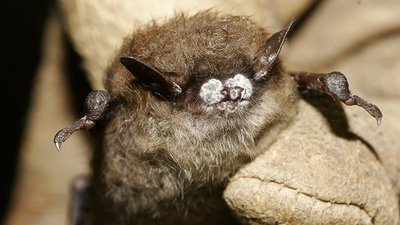White Nose Syndrome

Researchers associate WNS with a newly identified fungus (Pseduogymnoascus destructans) that thrives in cold, humid conditions found in caves and mines used by bats. Bats affected with WNS do not always have obvious fungal growth, but they may display abnormal behavior. The fungus has been known to be in Arkansas since 2012 and has been found in 14 counties across the Ozark and Ouachita Mountains.
We believe WNS is transmitted primarily from bat to bat. There is a strong possibility it can be transmitted by humans inadvertently carrying the fungus or its spores from cave to cave on their clothing and gear.
Bats may lose their fat reserves, which they need to survive hibernation. They may leave their hibernacula during winter and die. The number of bats dying in infected areas increases as winter progresses. WNS may be associated with some or all of the following unusual behaviors:
- White fungus, especially on the bat’s nose, but also on the wings, ears or tail
- Bats flying outside during the day in temperatures at or below freezing
- Bats clustered near the entrance of a hibernacula
- Dead or dying bats on the ground or on buildings, trees or other structures in winter
Hibernating bats may have other white fungus not associated with WNS.
If you see bats with signs of WNS in winter, contact Blake Sasse at the Arkansas Game and Fish Commission, 501-350-5703.
Tri-colored, little brown, northern long-eared, big brown, southeastern, small-footed bats, gray, and Indiana bats have been found with WNS symptoms or have died from the disease. Four other Arkansas species – eastern red bat, silver-haired bats, Rafinesque’s big-eared bats, and Ozark big-eared bats have been found with the fungus, but have not been confirmed with WNS.
Cavers should observe all cave closures and advisories and avoid caves, mines or passages containing hibernating bats. If cavers decide to go in a cave, they should decontaminate their clothing and gear in accordance with U.S. Fish and Wildlife Service guidelines. To learn more, visit www.whitenosesyndrome.org.
There is no evidence that WNS can affect humans. However, take precautions and do not expose yourself unnecessarily to WNS. Biologists and researchers use protective clothing when entering caves or handling bats.
More than 5 million bats have died from WNS, and there seems to be no end in sight. There have been cases of 90-100 percent mortality of bats (primarily little brown bats) at several hibernacula in New York, Massachusetts, Connecticut and Vermont. However, there may be differences in mortality by site and species. In Arkansas, little brown bats have almost been entirely wiped out and tricolored bats have seen declines of more than 88 percent since 2010.
The AGFC recommends private landowners prohibit access to their caves for the time being to help slow the spread of WNS by humans. If they do decide to allow access, they should require cavers to follow the guidelines above for decontamination of gear before and after going in the cave: If your cave has significant numbers of bats and you have had problems with illegal trespassing in the cave, please contact the AGFC as there may be programs available to fund cave protection measures at such sites.
